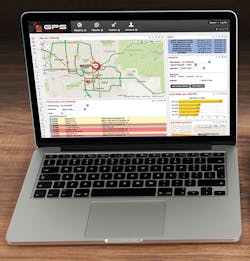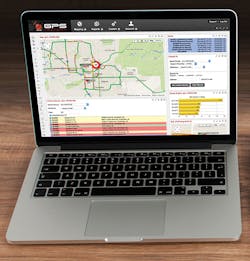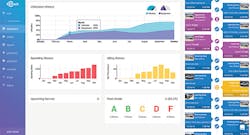Fleet managers have access to so much data the challenge becomes making sense of it all
CHICAGO — It used to be that fleet managers had little more to handle than tracking mileage and scheduling maintenance. Then came on-board GPS, and now most moderate-to-large size fleets have advanced telematics systems that are able to connect directly into a vehicle’s CAN bus (Controller Area Network bus).
A single CAN bus can talk to as many as 70 electronic control units for various vehicle subsystems including the engine, transmission, the antilock breaking system and more. Multiply that by 5, 10 or a hundred vehicles, complicate that with a mixed fleet (say, heavy duty and light duty trucks), not to mention a rotating crew of drivers, and the sheer amount of data becomes staggering.
GPS Insight
GPS Insight has been offering its proprietary fleet tracking solution since 2004. The main selling point — in fact, the starting point — for the GPS Insight business model is its customizability. It can be scaled up, scaled down, and tailor-fit to the specific user. (They have recently developed a GPS tracking solution for small businesses designed for quick implementation that delivers real-time fleet visibility).
That custom-fit is a huge help to fleet managers trying to make sense of the wealth of data the system provides. “We work with customers to create a prioritized list of business or fleet challenges that we will tackle together,” Ryan Driscoll, marketing director for GPS Insight, said.
By focusing on one challenge at a time and working closely with their customers an immense, highly complex problem becomes a series of smaller, more manageable problems. “For example,” Driscoll said, “if the monthly fuel bill was too high and needs to be reduced by 30%, we would help customers set up the appropriate alerts and reports so they are only monitoring that data.”
Once one business goal is under control it’s on to the next challenge. “This keeps things focused and simple, and we find it very effective,” Driscoll said.
EquipmentShare
“There is a huge amount of data we deal with every day,” Willy Schlacks, president and co-founder of EquipmentShare, said. “Just terabytes of data. Our goal is to make it as simple as possible for the end user.”
EquipmentShare.com had its start in Schlacks’ earlier ventures as a general contractor. He found his company in a dilemma most contractors face sooner or later: pay the high cost of renting equipment so you only have it when you need it, or else buy equipment and watch it sit idle when you don’t.
Schlacks calls it “the fundamental problem of asset utilization” — getting the most out of what you have. His solution was EquipmentShare, a secure platform and marketplace where contractors can rent out their idle equipment to other contractors. The contractor on the one end makes money off of equipment that would otherwise be sitting idle; the contractor on the other end enjoys a lower rate than they might find with a typical equipment rental company.
“Since we’re dealing with mobile assets,” Schlacks said, “the only way we could make the platform work was with a high level of connectivity, so in tandem we started building out a telematics platform, a full mixed-fleet platform that was really designed for contractors.”
Telematics proved to be the other part of the asset utilization equation. EquipmentShare has a team of developers focusing on the problems fleet managers face. When it comes to the fire hose of data, the best way to manage it, Schlacks found, is to get to know the fleet managers themselves and find out how they work.
Making sense of the data
“We love data, and we collect as much of it as possible, but the trick is parsing it down,” Schlacks said. “With fleet managers, most often, these guys know what they need, and it’s really a matter of zeroing in on how to display that data and give them what they’re looking for.”
For example, a lot of information goes into a report on a single driver. It may cover speed, hard cornering, hard breaking as well as accident and incident reports. And while all that data is available to the end user, the behavior gets boiled down into a scorecard that the user can look at in a second or two, then decide which employees require further training and which don’t.
“Your service costs will go up about 10% for vehicles that are driven aggressively,” Schlacks said, “between tires, transmission and consumables.”
Another example is customer alerts and alarms. If everything that happens outside of a set — sometimes arbitrary — parameter generates an e-mail or a text, things get lost in a blizzard of alarms. EquipmentShare allows alarms to be set, but for the most part handles the fleet manager’s “big picture” with an activity feed that can be filtered according to the level of impact different events are creating.
“So, having those tools that don’t necessarily rely on a text message or an e-mail possibly interrupting an owner or a user… having the tools where if they do want to see what’s going on they can immediately see,” Schlacks said. It’s all about finding that balance.
Above all, helping users to visualize the data is key to helping them make use of it. A string of numbers might not tell the story as well as a chart, graph or active map. Schlacks notes that something like, for example, haul tracks — the percentage of time a vehicle spends hauling a particular resource — can be difficult to understand without visualization tools, but is key to asset utilization.
Integration
One final way a company can “drink from the fire hose” of data that telematics systems provide is through integration. Instead of all the information going to one harried, overworked fleet manager, each member of the team gets just the numbers they need. The dispatchers get the information they need, the maintenance crews what they need, drivers, payroll and so on throughout the company — and it all happens automatically.
The various GPS Insight solutions are designed to be integrated with a company’s back-end software. That means payroll, tracking, dispatch and more can all be viewed on the same platform.
The EquipmentShare package actually integrates fleet management with fleet insurance. “We have an insurance company that we started,” Schlacks explained. “Its focus is to leverage telematics data and reduce insurance costs… Because it’s one company that owns both, there’s a free-flow of data between us all the way up to the underwriter.”
The company is incentivized to educate their users on what is and is not insurable behavior — what is and is not considered risky. “Say you have a million dollars worth of equipment,” Schlacks said, “and it’s getting 30 percent or lower utilization, and the bulk of that is just sitting in a fenced yard. The risk on that is much lower that that of equipment on a job site being used.”
It can lead to huge savings — as much as 50 percent — for companies using the system.
About the Author
Steve Spaulding
Editor-in-Chief - CONTRACTOR
Steve Spaulding is Editor-in-Chief for CONTRACTOR Magazine. He has been with the magazine since 1996, and has contributed to Radiant Living, NATE Magazine, and other Endeavor Media properties.


